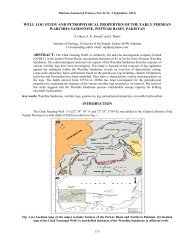GENETICALLY MODIFIED ORGANISMS (GMOs ... - Paas.com.pk
GENETICALLY MODIFIED ORGANISMS (GMOs ... - Paas.com.pk
GENETICALLY MODIFIED ORGANISMS (GMOs ... - Paas.com.pk
Create successful ePaper yourself
Turn your PDF publications into a flip-book with our unique Google optimized e-Paper software.
Pakistan Journal of Science (Vol. 64 No. 2 June, 2012)<br />
from a single GM tree has been shown to travel 1/5th of<br />
the length of the United States. Thus there is no check for<br />
such genetic pollution. Experiments in Germany have<br />
shown that engineered oilseed rape can have its pollen<br />
move over 200 meters. As a result German farmers have<br />
sued to stop field trials in Berlin. A recent study in<br />
England showed that despite the tiny amount of GM<br />
plantings there (33,750 acres over two years <strong>com</strong>pared to<br />
70-80 million acres per year in the US) wild honey was<br />
found to be contaminated. This means that bees are likely<br />
to pollinate organic plants and trees with transgenic<br />
elements. Many other insects transport the by-products of<br />
GM plants throughout our environment. (Nathan, 2009).<br />
Disturbance of Nature’s Boundaries: Genetic engineers<br />
argue that their creations are no different than<br />
crossbreeding. However, natural boundaries are violated<br />
– crossing animals with plants, strawberries with fish,<br />
grains, nuts, seeds, and legumes with bacteria, viruses,<br />
and fungi; or like human genes with swine. (Nathan,<br />
2009)<br />
Impact on farming<br />
General Economic Harm to Small Family Farms: GM<br />
seeds sell at a premium, unless purchased in large<br />
quantities, which creates a financial burden for small<br />
farmers. Many GM products, such as rBGH, seem to<br />
offer a boom for dairy farmers - helping their cows<br />
produce considerably more milk. But the end result has<br />
been a lowering of prices, again putting the smaller<br />
farmers out of business (Bucchini and Goldman, 2002).<br />
Losing Purity: At the present rate of proliferation of GM<br />
foods, within 50-100 years, the majority of organic foods<br />
may no longer be organic.(Nathan, 2009).<br />
Control and Dependency<br />
Terminator Technology: Plants are being genetically<br />
produced with no annual replenishing of perennial seeds<br />
so farmers will be<strong>com</strong>e wholly dependent on the seed<br />
provider. .(Nathan, 2009)<br />
Less Diversity, Quality, Quantity and Profit: One of<br />
the most misleading hopes raised by GM technology<br />
firms is that they will solve the world’s hunger. Some<br />
high technology agriculture does offer higher single crop<br />
yields. But organic farming techniques, with many<br />
different seeds inter-planted between rows, generally<br />
offer higher per acre yields. This applies best to the<br />
family farm, which feeds the majority of the Third<br />
World. It differs from the large-scale, monocrop<br />
<strong>com</strong>mercial production of industrialized nations. Even for<br />
<strong>com</strong>mercial fields, results are questionable. .(David,<br />
2001).<br />
Economic, Political and Social Threats<br />
Monopolization of Food Production: The rapid and<br />
radical change in the human diet was made possible by<br />
quick mergers and acquisitions that moved to control<br />
segments of the US farming industry. Although there are<br />
approximately 1500 seed <strong>com</strong>panies worldwide, about<br />
two dozen control more than 50% of the <strong>com</strong>mercial seed<br />
heritage of our planet. (Nathan, 2009).<br />
Impact on Long -Term Food Supply: If food<br />
production is monopolized, the future of that supply<br />
be<strong>com</strong>es dependent on the decisions of a few <strong>com</strong>panies<br />
and the viability of their seed stocks. (David, 2001).<br />
Biocolonization: In past centuries, countries managed to<br />
overrun others by means of fierce or technologically<br />
superior armies. The <strong>com</strong>bined control of genetic and<br />
agricultural resources holds a yet more powerful weapon<br />
for the invasion of cultures. For only when a person loses<br />
food self-sufficiency do they be<strong>com</strong>e wholly dependent<br />
and subservient ( Taylor and Tick, 2003).<br />
Table-1 Global area of biotech crops in 2007<br />
Country Area Biotech crops<br />
USA 57.7 Soybean, maize, cotton,canola,<br />
squash, papaya, alfalfa<br />
Brazil 15.0 Soybean, cotton<br />
Argentina 19.1 Soybean, maize, cotton<br />
Canada 7.0 Canola, maize, soybean<br />
India 6.2 Cotton<br />
China 3.8 Cotton, tomato, poplar, petunia,<br />
papaya, sweet pepper<br />
Paraguay 2.6 Soybean<br />
South Africa 1.8 Maize, soybean, cotton<br />
Uruguay 0.5 Soybean, maize<br />
Philippines 0.3 Maize<br />
Australia 0.1 Cotton<br />
Spain 0.1 Maize<br />
Mexico 0.1 Cotton, soybean<br />
Colombia















